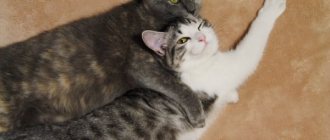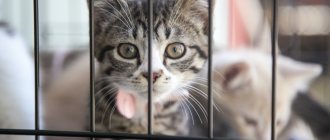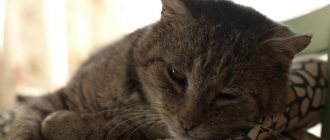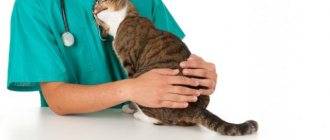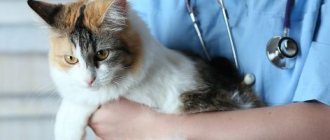Siamese kittens are cute and curious, like all babies. But these little blue-eyed lumps have a trait that from an early age distinguishes them from kittens of all other breeds: from birth it is a personality. If you are planning to get a Siamese kitten, try to find out as much as possible about it. This will greatly facilitate communication, education and care for him.
Description of the breed
Siamese cats are amazingly sophisticated creatures. Medium in size, flexible and graceful, they are distinguished by well-developed muscles and harmonious build.
The breed standard stipulates a head shape in the form of an equilateral triangle, large, elongated ears, slanted eyes, an elongated body, slender, dry limbs with collected paws in the shape of an oval and a thin flexible tail.
The Siamese's coat is short, soft, silky and lies close to the body. A contrast in the basic tone and markings is required, and the color of the fur on the face, ears, paws and tail must match. The back and sides should be slightly darker than the neck, chest and stomach.
Both the absence of points and weak contrast are considered unacceptable. Animals with knots and creases in the tail are also culled. This sign indicates degeneration due to inbreeding.
Eye color is supposed to be blue. Greenish tints are considered a deviation from the standard.
Varieties
Manufacturers distinguish several varieties of Siamese cats:
- True Siamese are distinguished by a narrow muzzle, increased thinness, large triangular ears, long paws and the same tail.
- Thai cats are very similar to Siamese, but have a dense body, rounded smooth lines and fluffiness.
- The Oriental breed has no points. Solid or spotted color, thinness is what distinguishes them from the Siamese representatives of the breed.
- The Mekong Bobtail is very similar to the Thai breed, but their tail is much shorter and wider.
Due to their particular popularity, breeders are working on creating new breeds of Siamese cats. Among them are the following types:
- Siamese-Persian cat. She is too beautiful and has a unique character. Beautiful blue eyes and Siamese coloring - these characteristic features are combined with long hair, which is unusual for other species.
- Burmese cat. Very similar to purebred Siamese, but her coat is semi-long, with the same darkening. It has white socks on its toes and paws. In terms of physique, it is absolutely no different from its Siamese relatives.
- Neva masquerade cat. She was bred by Russian breeders. It has a long, smooth coat and characteristic dark markings. The masquerade cat was created by crossing a Siberian species and a Siamese. They do not like loneliness and monitor the mood of their owners.
- Snow shu. It is distinguished by its point color with white tips on its paws. This breed was obtained by crossing a Siamese and an American Shorthair.
- Seychelles. Has a bicolor color. Representatives of this breed are elegant and slender, almost bald, but with a slight undercoat, their front legs are shorter than their hind legs. Too capricious and frivolous.
Also, as a separate subspecies, the fold-eared cat can be distinguished, which is very rare. The lop-eared pet is similar to the British breed, but differs in color and wayward character.
Character
The character of Siamese cats is often characterized by stubbornness and selfishness. This does not mean at all that they cannot become a devoted friend to a person. Just the opposite! Animals of this breed become very attached to their owner and literally run after him, reminiscent of small dogs in this way. And yet, for a Siamese, an owner is, first of all, a source of all kinds of benefits, and only then a friend and protector.
If there is only one cat in the house and everyone around her does nothing but caress her, admiring her intelligence and beauty, everything goes fine. But as soon as a competitor appears, be it a kitten or a puppy, the life of a new family member can turn into hell! There are often cases when you have to part with him in order to maintain peace and tranquility. There are exceptions if an older cat is introduced to a baby. Usually she calmly accepts him and subsequently friendship develops between the animals.
Mister Cat warns: differences between Siamese and Thai cats
The modern Siamese cat differs significantly from its ancient ancestor in terms of standard. She is sleeker and more like an oriental type. The Thai cat is an Old Siamese variety. The differences between the ancestor and the new type are significant.
On the left is a Siamese cat, on the right is a Thai cat
The body and head of the Thai are more rounded and less refined, the ears are not so widely spaced, and the eyes are rather round in shape. In some systems, this variety is identified as a separate breed, in others it is a subtype of the main species.
Thai kittens
There are also differences in character - there is no Siamese arrogance, these are softer and more obedient pets, selfless and devoted, but just as energetic and active.
Breeds developed using the Siamese cat
The Siamese cat fascinates with its elegance, unusual characteristic color-point color and sapphire eyes. Breeders of many cat lines are tempted to introduce these peculiar traits into their pets. As a result of breeding work based on the Siamese, the following breeds appeared:
- Australian;
- Burmese - short-haired Siamese without points;
- Balinese - Siamese and Angora combined with a long-haired Siamese;
- Himalayan (Khmer) - Siamese and Persian, fluffy mestizo with color-point color;
- jungala;
- California Speckled - Abyssinian, Siamese, British and American Shorthair, Manke, Persian, African and Asian street cats;
- Ocicat - Abyssinian and Siamese;
- snow-shu - Thai type in white socks;
- Neva Masquerade - Siamese and Siberian;
- Tonkinese - Samskaya and Burmese;
- Javanese - Siamese and Abyssinian.
Newborn kittens
Siamese cat kittens are born completely white, only their nose and paw pads are pink. Darkening of the coat can begin from two weeks of age, and one or another color is determined by the temperature in the room where the kitten is. In a very warm room, the main coat color will be milky white or cream, and the color of the markings will be chocolate. The cooler the apartment, the darker the color will be. Siamese kittens that are born and live outside (those that are trained to be mousecatchers in a barn or goat stall) after the first moult become dark brown, and their point color is almost black. The final color of a Siamese kitten is established only by ten months.
Health
With proper care and nutrition, the average lifespan of Siamese cats is 15-25 years.
They may also have problems with progressive retinal atrophy, which can lead to poor vision and even blindness. Glaucoma and strabismus are also common among eye diseases.
This breed is more prone to lung infections than others. The most common condition is asthma, which causes inflammation and narrowing of the lungs' airways.
These cats are known to have very sensitive stomachs. In addition, Siamese cats may have problems with the heart, kidneys and liver.
Choosing a kitten
Cat or cat?
Having decided to purchase a Siamese kitten, the future owner often does not know who to choose: a cat or a cat. At two to three months, all kittens are equally charming. But childhood does not last long, and when the pet grows up, its belonging to one gender or another will appear before the owner in all its glory.
Most owners of Siamese cats believe that the males of this breed are much more beautiful than the females. One cannot but agree with this opinion. The Siamese cat has a more impressive size; its body proportions are slightly different than those of females: the body is shorter and the head is larger. Some people believe that keeping a male is not particularly difficult, unlike a female. At least you won’t have to think about where to place the kittens.
However, this is not even the point. The problem of cat marks and unwanted offspring can be solved by castration or sterilization. What will stay with an animal forever is its character.
The Siamese cat feels like a sovereign master in the apartment. He perceives the owners as servants who must fulfill his every whim. He is curious, active, loves to poke his nose everywhere, especially where he is not allowed. Often irritable and aggressive.
Cats of this breed have a much calmer, affectionate character. They become very attached to a person (most often this is the owner), and vigorously show their love and devotion. And the cleanliness of Siamese dogs is legendary!
Although there are no rules without exceptions.
Choice depending on color
After you have decided on the gender of your future pet, you need to decide what color you like.
Most often, when people think of a Siamese kitten, they think of the classic sealpoint: cream coat, dark markings and beautiful blue eyes. The image is truly captivating, but this color is by no means the only one. Bluepoint (snow-white coat color with blue-gray markings), redpoint (white background color and apricot or red markings), lilacpoint (silver coat with lilac-pink markings)… It’s easy to get confused! But there are other colors: chocolate point (an ivory coat with very dark, almost black markings), cinnamon point (ivory and brownish points), caramel point (an absolutely amazing, indescribable shade of coat with gray-pink points), tabbypoint (lovely solid-colored cats with striped markings), tortiepoint (a fantastic combination of calm background color and spotted points).
The eye color of Siamese cats depends on the color of the coat: the darker and more saturated the color of the animal, the brighter and deeper the blue will be.
There is an opinion (though not yet confirmed by anything other than the words of the owners) that cats of different colors have different personalities. For example, it is believed that the temperament of bluepoints is much softer and more pleasant than that of sealpoints or chocolate points.
Feeding
The choice of food for a Siamese cat should be approached as responsibly as possible. These exotic oriental beauties are considered too picky when it comes to food and can show fickle tastes. Some of their preferences cause sincere bewilderment among the owners.
For example, a Siamese can happily eat nuts or mushrooms. They also love different fruits. But you shouldn’t indulge your pet; the owner must provide the cat with a balanced, properly selected diet. Whether it is natural food or feeding with ready-made food is up to you.
Natural nutrition
The basis of the natural diet of all cats should be meat. When creating a menu for a Siamese cat, you need to take into account the fact that representatives of this breed have darker fur from excess red meat in their diet. Therefore, 30% of animal proteins should come from fish.
Animal proteins should make up 70% of the menu:
- lean meat (rabbit, beef, turkey, chicken breast, lamb, game);
- sea fish (navaga, cod, tuna, flounder);
- shrimps;
- quail eggs;
- beef liver – 1-2 times a week.
What else should be in the diet:
- skim cheese;
- kefir, yogurt, fermented baked milk;
- vegetables (carrots, broccoli, zucchini, pumpkin, squash, cauliflower);
- fruits (apple, pear, banana) - as a treat;
- olive oil;
- greens (spinach, lettuce);
- Brewer's yeast;
- bran;
- dried seaweed (kelp).
All cats on a natural diet are prescribed vitamin and mineral complexes.
Prohibited products:
- bones (chicken, fish);
- milk;
- sweets;
- flour;
- onion garlic;
- fatty pork;
- sausage;
- legumes;
- smoked meats
- spices.
The daily serving volume is calculated using the formula: 7-7.5% of the cat’s weight. Adult cats need two meals a day.
Important!
Don't forget about access to clean water. It should be open 24/7. Many Siamese love to drink from large dishes and from the tap - pour water into a large container or buy a fountain drinker.
The monthly budget for a natural diet is 1000-1500 rubles.
Industrial feed
When making a choice in favor of one or another ready-made food, you need to assess the condition of your pet, its age and level of mobility. Avoid cheap “economy class” food from the beginning. High-quality brands of the “super-premium” and “holistic” classes are suitable for purebred cats. Do not forget about the breed characteristics - alternate meat and fish compositions.
Recommended brands:
- Orijen Cat Six Fish Grain Free – high-quality dry diet of holistic fish;
- Acana Regionals Grasslands Cat Grain-Free – dry meat and fish formula;
- Bozita Feline Shrimps - Chunks in Sauce - a wet diet based on meat and shrimp;
- 1st Choice Adult Cat Finicky Chicken Formula – for adult picky cats;
- Optima Nova Adult Cat Exquisite Chicken & Rice – with rice and chicken for picky-eating pets;
- AATU For Cats Free Run Chicken - food based on chicken and salmon;
- Royal Canin Siamese Adult – for adult Siamese cats.
The daily feeding rate is calculated based on the age, weight and activity of the pet. On average, Siamese cats need 45-70 grams of dry food per day.
Every month it will cost from 900 to 2300 rubles to feed a cat.
Read more about top cat foods and what to feed Siamese kittens.
Care and maintenance
Features of caring for a kitten aged 1 month The kitten you want to buy should be at least two, and preferably three to four months old. At this age, kittens completely switch to normal food, are practically independent of their mother, are curious and very sociable. The baby will willingly make friends with you and the rest of the family.
If you get a kitten that is at least a month old, difficulties cannot be avoided. Such kids have great difficulty making contact. If there are small children in the family, it is advisable to completely protect the kitten from their attention. Absolutely everything scares him: large (as much as two meters!) distances, loud sounds, an unexpectedly chirping sparrow... The first days he can sit in the sofa or the pocket of an old bag, secretly getting out of there to grab a piece of food or go to the toilet. One person must take care of such a baby. You should not force him out of hiding and poke his muzzle into the food if he resists. The best thing you can do is leave him alone and quietly observe. Let your baby get comfortable. Only when the kitten stops hiding at every rustle can you begin to introduce him to the whole family.
Diseases
Typically, this breed of cat is resistant to disease and has a fairly strong immune system. They rarely get sick, but some diseases can develop:
- Genetic liver amyloidosis, a disease that results in liver failure; Cardiomyopathy; Tumor of the mammary gland, the risk of the disease can be reduced if you sterilize a cat under 1 year old that does not have offspring; Gingivitis and dental problems, which are also common in other animals, this problem can be solved by a visit to a specialist; Rare colds as a result of hypothermia or being in a cool room; Fleas and worms. These parasites are easily removed thanks to drops and tablets, but care and dosage must be taken so as not to harm the health of the pet.
We live in an apartment, and when we were away for a long time, we took our pet to grandma’s in the village in a private house. There he got used to running along the street, which he was incredibly happy about and earned himself a cold and a sore throat. We had no idea that cats suffered from such diseases, but the veterinarian prescribed medications and everything ended well.
Hygiene procedures
Caring for little Siamese is surprisingly easy. Their short coat, devoid of even a hint of undercoat, looks great without any water treatments. It is enough to rub it with a special mitten, and from 4 months - with a soft brush.
Carefully monitor the condition of your pet's ears and eyes. Wipe them daily with a damp cotton pad. If you find the slightest sign of discharge, immediately show the kitten to a doctor. Any disease in children is much more severe than in adult animals, so the sooner treatment is started, the better.
Raising a Siamese
As already mentioned, Siamese are smart and savvy. Therefore, accustoming them to a lifestyle that is convenient for you is not so difficult, but this must be done from an early age. The caregiver will have to be patient and find an approach to a pet with an independent character.
Sleeping area
In order to grow and get stronger, a small kitten needs a lot of sleep. The resting place must meet the needs of the animal:
- The main condition for a kitten to feel comfortable is warmth. Therefore, the place should be far from drafts, but it should not be located close to heating appliances in winter;
- cats love secluded places, so observe where the kitten most often likes to fall asleep (but not in the owner’s bed);
- cats, even when immersed in slumber, are constantly on the alert, so from their hiding place the animal must be able to observe the surrounding space.
A place to rest can be equipped in a wicker basket, lining it inside with a warm blanket or in a cardboard box, having previously covered it with soft fabric. In specialized stores you can purchase ready-made soft houses for cats.
You need to prepare a cozy and comfortable place for your baby.
Toilet training
A naturally clean Siamese can be quickly trained to relieve his natural needs in one, specially designated place. But for this you need to prepare a container, preferably plastic (it is easy to clean) and filler. The kitten may not like containers with bars, because from birth he has an inherent need to bury his waste products. If you don’t clean and wash the tray in time, the little neat guy will find another place for himself, and perhaps more than one.
By the way, about the place for the tray. It should be as comfortable as possible for the kitten. It is advisable to select a secluded place, closed from prying eyes, and the animal should have free access to it. As soon as you notice that your baby is looking for a place to relieve himself, immediately take him to the litter box and leave him there. After the kitten has successfully completed the task, be sure to praise him. And do this every time, developing a reflex in the animal. And positive emotions will only accelerate the habit.
Don't forget to regularly clean and disinfect not only the tray, but also the area where the cat's litter box is located.
If you teach a Siamese to order from an early age, there will be no problems.
Hygiene procedures
From an early age, teach your baby to hygiene procedures. But first, teach him not to be afraid of your touch. Stroke the animal, but do not make sudden movements. A pet that is accustomed to being groomed will not have the desire to scratch or bite you during treatment.
How to deal with bad habits
The wayward Siamese has a lot of bad habits that you have to overcome. But first you need to calm the animal down. In the first days of being in a new environment, he may behave restlessly and meow constantly. This is understandable, because he was separated from his mother, and the baby does not yet understand where he ended up. Your task is to remind your pet as often as possible that he is in caring hands. To do this, pet your baby more often and speak kind words to him.
If your cat wakes you up in the morning with frantic screams demanding food, then try to wean him off this in the following way. Do morning feeding not when you get out of bed, but before leaving for work. This will require patience and time. But very soon the Siamese will become accustomed to the new regime, and he will sleep peacefully in the morning.
A Siamese may also complain due to lack of attention to his person. Therefore, think about whether you are paying enough attention to your pet. After all, for its active energy there must be a way out. Find free time to play with your cat, this will only strengthen your bond.
If you pay little attention to your pet, he begins to entertain himself
Sharpening the claws of Siamese, just like other cats, is a physiological need. Therefore, at first, try to cover upholstered furniture with covers and raise the curtains higher. Carefully observe where your tomboy most often performs this procedure. This is where you will install the scratching post. You can buy it at a pet store or build it yourself by attaching a plastic pipe to the base and wrapping it with thick rope.
In addition to instilling useful skills in your child, you yourself should serve as a role model. Do not throw clothes anywhere, put shoes on shelves, and do not leave leftover food on the table. If there is no temptation, the Siamese will not do any mischief. And most importantly, training should always end with encouragement. And your screams or spanks will not end well.
What to name a Siamese kitten
It is unlikely that anyone would think of calling a Siamese aristocrat Barsik or Murzik. Meanwhile, these sonorous nicknames perfectly demonstrate the principle by which you need to choose a name: a distinct, sonorous beginning and the absence of hissing sounds. If you can’t do without hissing sounds, let these sounds be in the middle of the name.
Let's try to come up with a beautiful, euphonious name for the pet.
If it's a boy, you can name him:
- Athos;
- Basil;
- Bertie;
- Leslie;
- Nelson;
- Nestor;
- Maurice;
- Solomon;
- Tyson;
- Everett.
If: you have a cat:
- Alice;
- Anfisa
- Bertha;
- Beatrix;
- Ophelia;
- Saji;
- Sona;
- Sookie
- Tess;
- Ulsi.
Where can I buy
You can buy a Siamese kitten in Moscow from one of the nurseries:
- "Sharess-Ori" (cattery of Oriental and Siamese cats);
- "Salambo" (oriental and Siamese cattery);
- "Marsiori" (oriental cattery).
You can choose the baby you like among the ads on Avito or use. Of course, in this case it will be difficult to find a purebred kitten with a pedigree, although there are exceptions - for example, if the owners move to another country and cannot take their pet with them, it will be very important for them that it ends up in good hands.
If it is not the pedigree that is important to you, but the point color, this is a good choice. But you must be prepared for the fact that the kitten you choose is only half Siamese. As he grows up, he may become aggressive, and you will have to make a lot of effort to correct his character.
Reviews
Reviews about pets are very different, but even negative ones cannot consider Siamese angry, vindictive or excessively aggressive. Experts believe that earlier, when kinks or bends in the tail were considered a point of the breed, the nerve endings were simultaneously pinched and the vertebrae were bent. The kitty felt constant pain and discomfort, so she was not inclined to tenderness or affection.
Owners described their Siamese kittens as “incredibly smart,” “the most affectionate creatures,” using the “toilet like a human,” able to accept training techniques, and playful and active friends with “the mother-in-law and the German shepherd.” Among the disadvantages, they noted loudness and excessive purring, jealousy, the requirement of absolute hygiene, vindictiveness, touchiness, and willfulness. Get such a pet and form your opinion about its character and personality.

